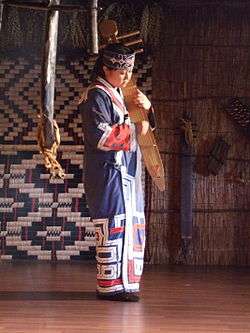Kankō Ainu
Kankō Ainu (Japanese: 観光アイヌ, "tourist Ainu") are Ainu who live or portray a traditional (or romanticised pseudo-traditional) indigenous Japanese Ainu lifestyle in order to cater to the tourist industry.

A woman performs on the traditional tonkori while dressed in traditional Ainu attire.
The practise has been criticised on multiple levels and protested by some Ainu advocates,[1] including complaints that tourist Ainu sites do not represent genuine Ainu culture, but rather a stereotype of the Ainu from the wajin (majority Japanese) perspective.[2] Other Ainu, however, are pleased to be able to make a living producing and selling traditional Ainu handicrafts, and performing Ainu dances for an audience.[3]
See also
- Living history museum
References
- Fred C. C. Peng; Peter Geiser (1977). The Ainu: The Past in the Present. Bunka Hyoron Publishing Company. Retrieved 18 August 2013.
- John Christopher Maher; Gaynor Marilyn Macdonald (1995). Diversity In Japanese Culture. Routledge. pp. 90–. ISBN 978-0-7103-0477-3. Retrieved 18 August 2013.
- Guy De La Rupelle (2005). Kayak and Land Journeys in Ainu Mosir: Among the Ainu of Hokkaido. iUniverse. pp. 113–. ISBN 978-0-595-34644-8. Retrieved 18 August 2013.
Further reading
- Takeshi Higashimura, Kanko Ainu' ni miru Wajin no Ainu Minzoku Sabetsu (Ainu Discrimination as Seen through Ainu Tourism). Kaiho Shakaigaku vol. 9 1995: pp. 65–85. (in Japanese)
This article is issued from Wikipedia. The text is licensed under Creative Commons - Attribution - Sharealike. Additional terms may apply for the media files.